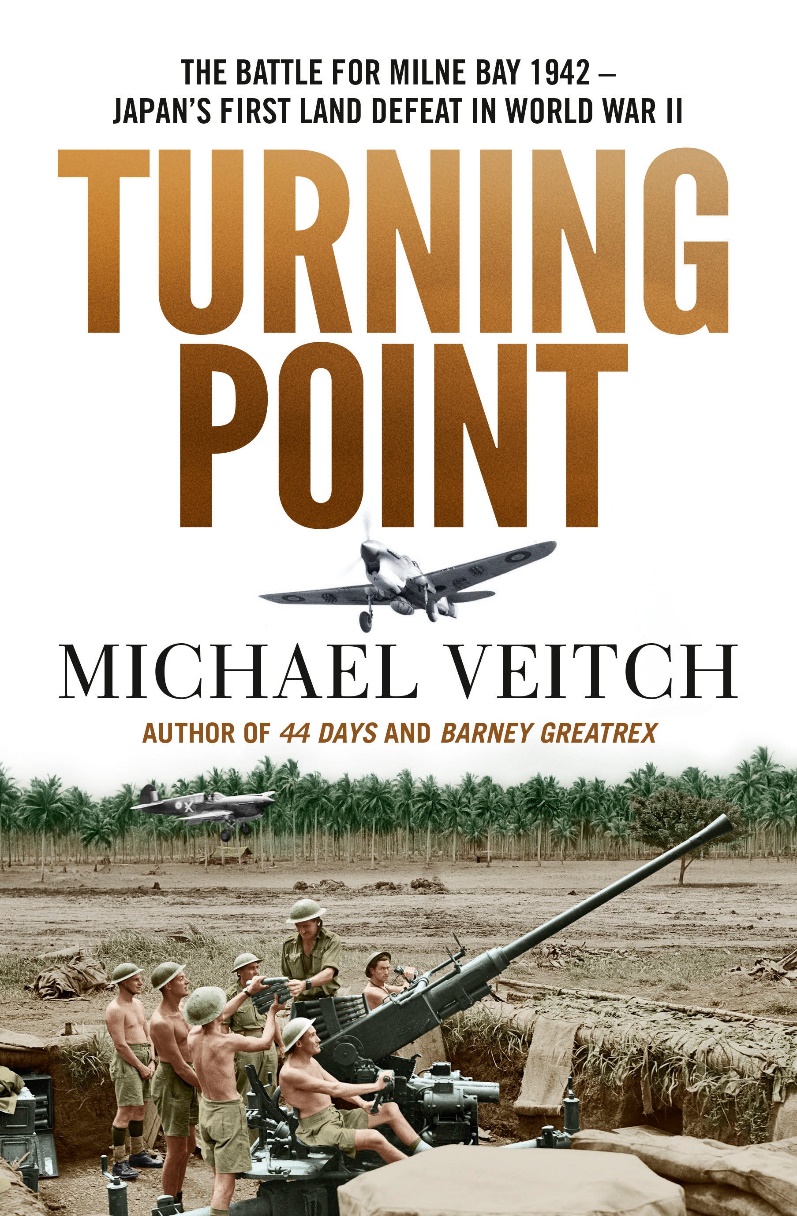At a remote airstrip in Milne Bay stands a simple monument with an inscription: “This marks the westernmost point of the Japanese advance, Aug – Sep 42. 85 unknown marines lie buried here.” It is a modest monument to a great achievement, summed up by Brigadier John Field, who commanded the 7th Brigade, Citizen Military Forces, at Milne Bay with the comment: “Small in comparison to some of the sustained and desperate fighting which took place in the Pacific … yet it was the first Australian victory against the Japanese invader, and brought to a halt the long series of territorial gains which the enemy had seemed to achieve with relative ease. Henceforth the tide was destined to turn.”
In Turning Point: Battle for Milne Bay 1942, Michael Veitch has produced a superb historical account of Australia’s first victory against a determined, well trained enemy seeking control of a vital airstrip on the eastern end of Papua. From there, the Japanese planned to control the northern approaches to Australia, use Milne Bay as a springboard to capture Port Moresby, and neutralise the Australian war effort. It is an easy-to-read book recounting the severe trials of the Australian troops and United States Army Engineers who carved out an airstrip in a malaria infested quagmire in which men floundered and vehicles struggled to stay afloat in a sea of mud. The airstrip was constructed by the U.S. Army Engineers who, along with their heavy equipment, accompanied by the initial force of Australian troops, were transported to Milne Bay on two Dutch ships, escorted by two Australian Navy warships.

Hachette Australia: Sydney; 2019; 334 pp; ISBN 978073340551 (paperback); RRP $32.99
In their quest to build an airstrip from where they hoped to repel the expected Japanese invasion, the Allied force had the assistance of the local population. Unlike the inhumane treatment suffered at the hands of the Japanese Special Landing Force (Marines), the local population was treated with respect and dignity by the Australians and were justly rewarded for their labour.
Following the completion of No. 1 Airstrip at Gill Gill, the focal point of Allied air and land forces began construction of another airstrip. It is important to note that, without the use of perforated steel planking known as Marston, the airstrip would not have been capable of supporting air operations. Marston planking was the product of research conducted by the U.S. Army Corps of Engineers at Marston, North Carolina, and was used for the first time at Milne Bay.
The soldiers of the Australian Imperial Force, the Militia, and the air and ground crews of the Royal Australian Air Force put aside their single-Service attitudes that had been formed following the fall of Singapore and melded into an effective fighting force, each fully supportive of the other. Allied soldiers and airmen suffered terribly during the preparation for and conduct of the battle as a result of the horrendous weather. Noted for its rainfall, the Battle for Milne Bay was conducted during a period of unseasonably heavy downpours. With a cloud base of less than 1000 feet, and generally almost to the ground, flying in those conditions was dangerous in the extreme – and then of course, there was the enemy to contend with.
Added to the strain of flying in atrocious weather conditions, pilots flew in shorts and boots while suffering from the effects of dysentery, fouling their cockpits. Michael Veitch blends the history of the battle with the personal insights of those who flew combat missions, prepared the airstrips and supporting infrastructure, and fought the Japanese in desperate and bitter combat at close quarters. As the ‘fog of war’ settled, there was significant uncertainty surrounding the outcome of the conflict and while the outcome of the battle is known, the author generates a sense of excitement throughout his description of these actions which readily engages the reader.
The Battle for Milne Bay was Australia’s first victory against the Japanese; indeed, it was the first land defeat suffered by the advancing Japanese forces, and yet several respected works on Australia’s wars have neglected to reference this battle. Turning Point: Battle for Milne Bay 1942 helps to address these omissions.
The Australian commander, Major General Cyril Clowes, received scant recognition for brilliantly achieving this victory. He apparently ran foul of General MacArthur and General Blamey for failing to respond to their requests for information during the height of the battle. He is a much-forgotten Australian hero.
Michael Veitch is well known as an author, actor, comedian and former ABC television and radio presenter. His books include the critically acclaimed accounts of Australian airmen in World War II: 44 Days; Heroes of the Skies; Fly; Flak; and Barney Greatrex. He lives in the Yarra Valley, outside Melbourne. This book should appeal to any reader who has even a passing interest in Australia’s military history. It is informative and easy to read.
Reviewed by Bob Treloar
Contact Royal United Services Institute about this article.






